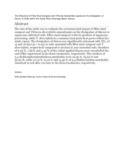| dc.contributor.author | Kimosop, Selly Jemutai | |
| dc.contributor.author | Orata, Francis | |
| dc.contributor.author | Getenga, Zachary | |
| dc.date.accessioned | 2021-06-09T07:09:10Z | |
| dc.date.available | 2021-06-09T07:09:10Z | |
| dc.date.issued | 2012-05-22 | |
| dc.identifier.uri | htttps://doi.org/10.1007/S00128-012-0685-9 | |
| dc.identifier.uri | https://link.springer.com/article/10.1007/s00128-012-0685-9 | |
| dc.identifier.uri | http://r-library.mmust.ac.ke/123456789/1650 | |
| dc.description.abstract | The aim of the study was to evaluate the environmental impact of filter mud compost and Tithonia diversifoila amendments on the dissipation of diuron in sugarcane cultivated soils. Filter mud compost is the by-product of sugarcane processing, while T. diversifoila is a common local plant that grows within the study region. The dissipation of diuron was significantly enhanced with DT50 of 15 and 16 days (p < 0.05) in soils amended with filter mud compost and T. diversifoila, respectively compared to 26 days in non-amended soils. Residues of 0.93 %, 1.83 % and 5.40 % of the initial applied diuron were recorded at the end of the experiment in the three treatments, respectively. The residues of 3,4-dichlorophenylmethylurea metabolite were 22.93 %, 25.92 % and 30.93 %, while 10.19 %, 12.19 % and 15.46 % of 3,4-dichloroaniline metabolite remained in soil after 112 days in the three treatments, respectively. | en_US |
| dc.language.iso | en | en_US |
| dc.publisher | Bulletin of Environmental Contamination and Toxicology | en_US |
| dc.subject | Influence, Filter Mud, Compost, Tithonia, diversifolia, Leaves, Dissipation, Diuron,Soils | en_US |
| dc.title | The Influence of Filter Mud Compost and Tithonia diversifolia Leaves on the Dissipation of Diuron in Soils within the Nzoia River Drainage Basin, Kenya | en_US |
| dc.type | Article | en_US |

